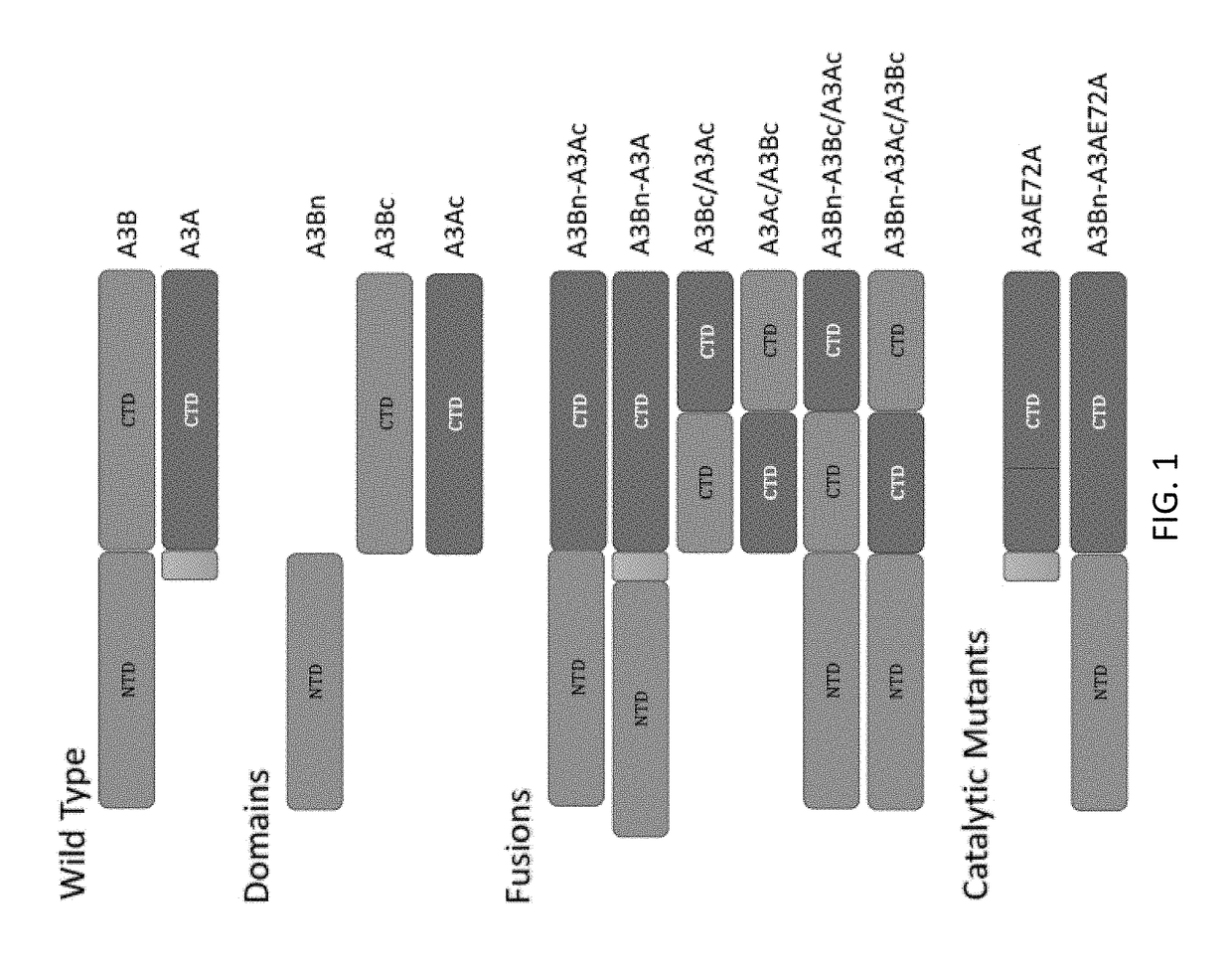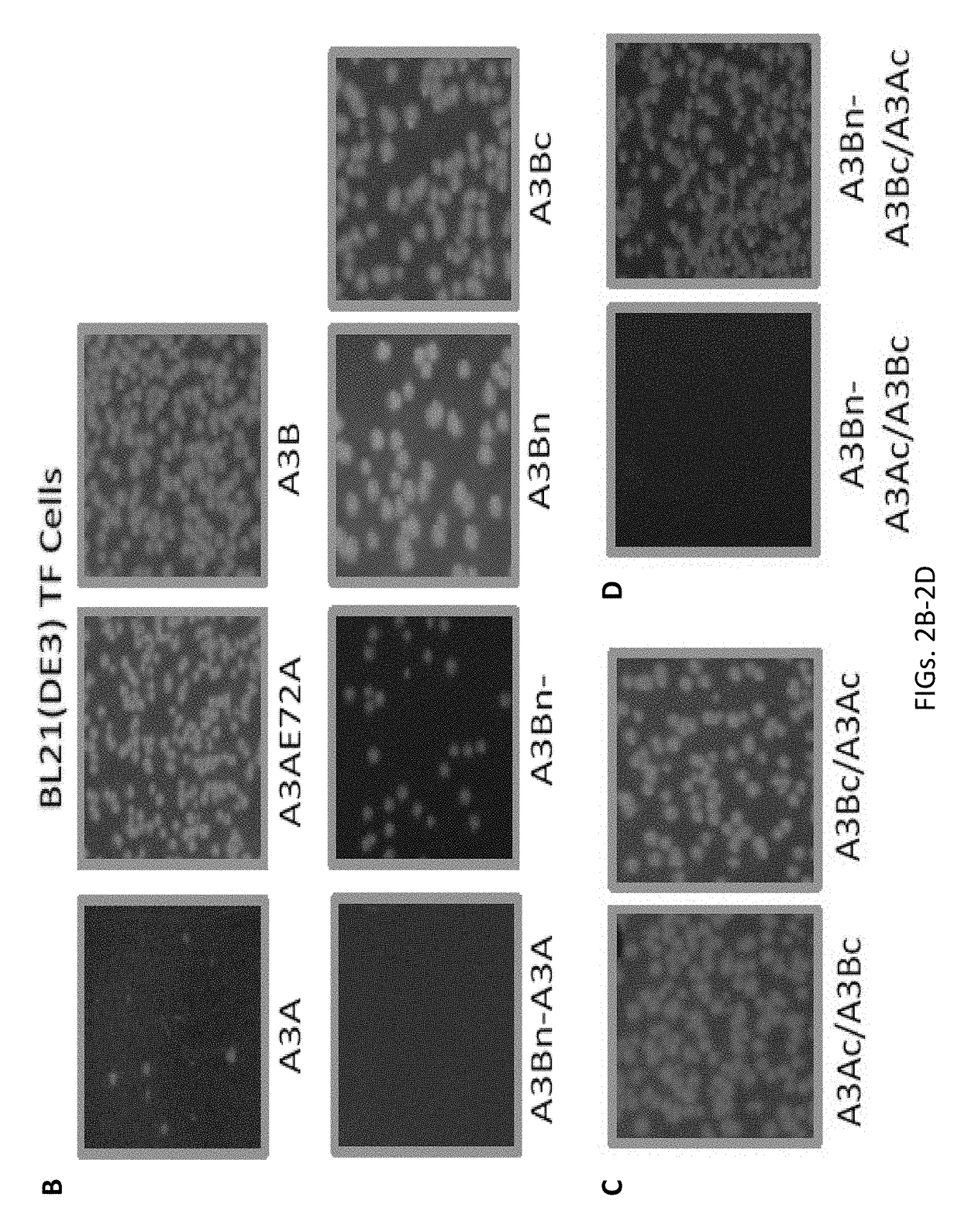Hyperactive AID/APOBEC and hmC Dominant TET Enzymes
a technology of tet enzymes and hyperactive aids, which is applied in the field of hyperactive aids/apobec and hmc dominant tet enzymes, can solve the problems of requiring the breakage of linkages, the function of each individual base and the mechanism governing their formation are currently unknown, and the need to break the linkag
- Summary
- Abstract
- Description
- Claims
- Application Information
AI Technical Summary
Benefits of technology
Problems solved by technology
Method used
Image
Examples
experimental examples
[0079]The invention is now described with reference to the following Examples. These Examples are provided for the purpose of illustration only, and the invention is not limited to these Examples, but rather encompasses all variations that are evident as a result of the teachings provided herein.
example 1
per-Active Mutants
[0080]The materials and methods employed in the experiments of Example 1 are now described.
[0081]Sequences of Constructs:
[0082]The human APOBEC3A (A3A) sequence (SEQ ID NO: 2) and the human APOBEC3B (A3B) (SEQ ID NO: 3) isoform sequences were used as the wildtype sequences. The catalytic mutants have a glutamic acid to alanine mutation at position 72 in the A3A sequence. A schematic of the different constructs created is shown in FIG. 1. The protein sequences for the different APOBEC constructs are shown below (SEQ ID NOs. 2-14). Silent mutations were introduced in the constructs to optimize for cloning. Nucleic acid sequences for the different APOBEC constructs are also shown below (SEQ ID NOs. 26-38).
MBP (SEQ ID NO: 1):MKIEEGKLVIWINGDKGYNGLAEVGKKFEKDTGIKVTVEHPDKLEEKFPQVAATGDGPDIIFWAHDRFGGYAQSGLLADTPDKAFQDKLYPFTWDAVRYNGKLIAYPIAVEALSLIYNKDLLPNPPKTWEEIPALDKELKAKGKSALMFNLQEPYFTWPLIAADGGYAFKYENGKYDIKDVGVDNAGAKAGLTFLVDLIKNKHMNADTDYSIAEAAFNKGETAMTINGPWAWSNIDTSKVNYGVTVLP...
example 2
active Mutants
[0118]The materials and methods employed in the experiments of Example 2 are now described.
[0119]Hyperactive AID mutant proteins were generated herein (SEQ ID NOs. 16-20). Nucleic acid sequences of the AID mutants are also disclosed herein (SEQ ID NOs. 40-44).
Wild Type AID (Genbank Accession No. NP_065712)(SEQ ID NO: 15):MDSLLMNRRKFLYQFKNVRWAKGRRETYLCYVVKRRDSATSFSLDFGYLRNKNGCHVELLFLRYISDWDLDPGRCYRVTWFTSWSPCYDCARHVADFLRGNPNLSLRIFTARLYFCEDRKAEPEGLRRLHRAGVQIAIMTFKDYFYCWNTFVENHERTFKAWEGLHENSVRLSRQLRRILLPLYEVDDLRDAFRTLGL*HyperAID-1 (AID-7.3-cvBEST-1-181) (SEQ IDNO: 16):MDSLLMNRREFLYQFKNVRWAKGRRETYLCYVVKRRDSATSFSLDFGYLRNKNGCHVELLFLRYISDWDLDPGRCYRVTWFISWSPCYDCARHVADFLRGNPNLSLRIFTARLYFCEAGRREPEGLRRLHRAGVQIAIMTFKDYFYCWNTFVENHGRTFKAWEGLHENSVRLSRQLRRILL*Mutations compared to wild-type AID: K10E, T82I, D118A, R119G, K120R, A121R, E156G, P182*HyperAID-2 (AID-7.3-cvBEST) (SEQ ID NO: 17):MDSLLMNRREFLYQFKNVRWAKGRRETYLCYVVKRRDSATSFSLDFGYLRNKNGCHVELLFLRYISDWDLDPGRCYRVTWFISWSPCYDCARHVADF...
PUM
 Login to View More
Login to View More Abstract
Description
Claims
Application Information
 Login to View More
Login to View More - R&D
- Intellectual Property
- Life Sciences
- Materials
- Tech Scout
- Unparalleled Data Quality
- Higher Quality Content
- 60% Fewer Hallucinations
Browse by: Latest US Patents, China's latest patents, Technical Efficacy Thesaurus, Application Domain, Technology Topic, Popular Technical Reports.
© 2025 PatSnap. All rights reserved.Legal|Privacy policy|Modern Slavery Act Transparency Statement|Sitemap|About US| Contact US: help@patsnap.com



